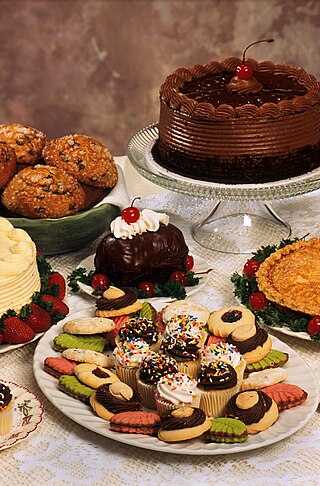
Dessert is a course that concludes a meal. The course consists of sweet foods, such as cake, and possibly a beverage such as dessert wine and liqueur. Some cultures sweeten foods that are more commonly savory to create desserts. In some parts of the world there is no tradition of a dessert course to conclude a meal.
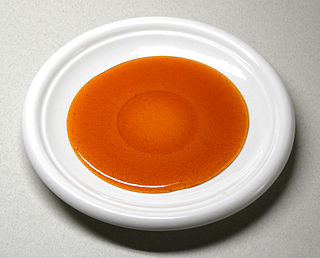
Caramel is an orange-brown confectionery product made by heating a range of sugars. It can be used as a flavoring in puddings and desserts, as a filling in bonbons or candy bars, or as a topping for ice cream and custard.

A chocolate bar is a confection containing chocolate, which may also contain layerings or mixtures that include nuts, fruit, caramel, nougat, and wafers. A flat, easily breakable, chocolate bar is also called a tablet. In some varieties of English and food labeling standards, the term chocolate bar is reserved for bars of solid chocolate, with candy bar used for products with additional ingredients.

Pralines are confections containing nuts – usually almonds, pecans and hazelnuts – and sugar. Cream is a common third ingredient.
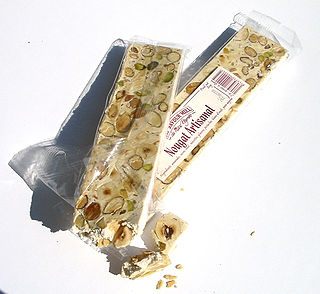
Nougat is a family of confections made with sugar or honey, roasted nuts, whipped egg whites, and sometimes chopped candied fruit. The consistency of nougat is chewy, and it is used in a variety of candy bars and chocolates. The word nougat comes from Occitan pan nogat, seemingly from Latin panis nucatus 'nut bread'.
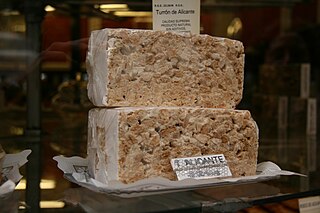
Turrón, torró and torrone is a southwest European nougat confection, typically made of honey, sugar, and egg white, with toasted almonds or other nuts, and usually shaped either into a rectangular tablet or a round cake. Turrón is usually eaten as a dessert food around Christmas in Spain and Italy. It's also known in Portugal and the countries of Latin America.
3 Musketeers is a candy bar made in the United States and Canada by Mars, Incorporated. It is a candy bar consisting of chocolate-covered, fluffy, whipped nougat. It is a lighter candy bar similar to the global Milky Way bar and similar to the American version Milky Way bar only smaller and without the caramel topping. The 3 Musketeers Bar was the third brand produced and manufactured by M&M/Mars, introduced in 1932. Originally, it had three pieces in one package, flavored chocolate, strawberry and vanilla; hence the name, which was derived from the 1844 novel The Three Musketeers by Alexandre Dumas. Rising costs and wartime restrictions on sugar saw the phasing out of the vanilla and strawberry pieces to leave only the more popular chocolate. Costing five cents when it was introduced, it was marketed as one of the largest chocolate bars available, one that could be shared by friends.

Maltesers are a British confectionery product manufactured by Mars, Incorporated. First sold in the UK in 1937, they were originally aimed at women. They have since been sold in Europe, Australia, New Zealand, Canada, United States and Middle East. The slogan is "The lighter way to enjoy chocolate".

The Idaho Spud is a candy bar made by the Idaho Candy Company. It has been produced since 1918 and is distributed primarily throughout the Pacific Northwest region of the United States. The wrapper of the product bears the slogan "The Candy Bar That Makes Idaho Famous". The bar was invented by Thomas "T.O." Smith, who founded the Idaho Candy Company in 1901.

Leaf International BV was a confectionery company founded in the 1940s. Leaf had sales of approximately €527m (2010) and 2,400 employees. It had 11 factories in seven countries. Leaf was owned by CVC Capital Partners, Nordic Capital, and management. Bengt Baron was the CEO of Leaf.
The U-NO Bar is produced by the Annabelle Candy Company.
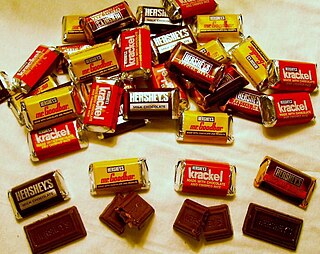
Hershey's Miniatures are neapolitan candy bars sold by The Hershey Company in packages of individually wrapped chocolates. The current assortment contains traditional Hershey bars, Mr. Goodbar, Hershey's Special Dark, and Krackel bars.
The following outline is provided as an overview of and topical guide to chocolate:

A candy bar is a type of candy that is in the shape of a bar. The most common type of candy bar is the chocolate bar, including both bars made of solid chocolate and combination candy bars, which are candy bars that combine chocolate with other ingredients, such as nuts, caramel, nougat, or wafers.

Knoppers is a brand of wafer candy bar layered with hazelnut and milk crème, produced by August Storck, first launched in West Germany in 1983. It has since been made available in over 50 countries, mainly in Europe but also Vietnam, Russia and more recently, the United Kingdom, Australia, New Zealand, and the United States. A bar weighs 25 grams (0.9 oz) and typically has a light-blue-and-white wrapper. Knoppers are manufactured at Storck production sites in Germany.












